Japan is one of the world’s most fascinating destinations, and it’s increasingly becoming one of the most accessible. From barrier-free train stations to wheelchair-friendly taxis, accessible toilets, and guided Japan shore excursions designed for people with mobility challenges, traveling around Japan with special needs is now more possible than ever. This guide will take you step by step through the journey of accessible travel in Japan. You’ll find practical advice for wheelchair users, senior travelers, and families who require special assistance.
Preparing for Your Trip with Special Needs
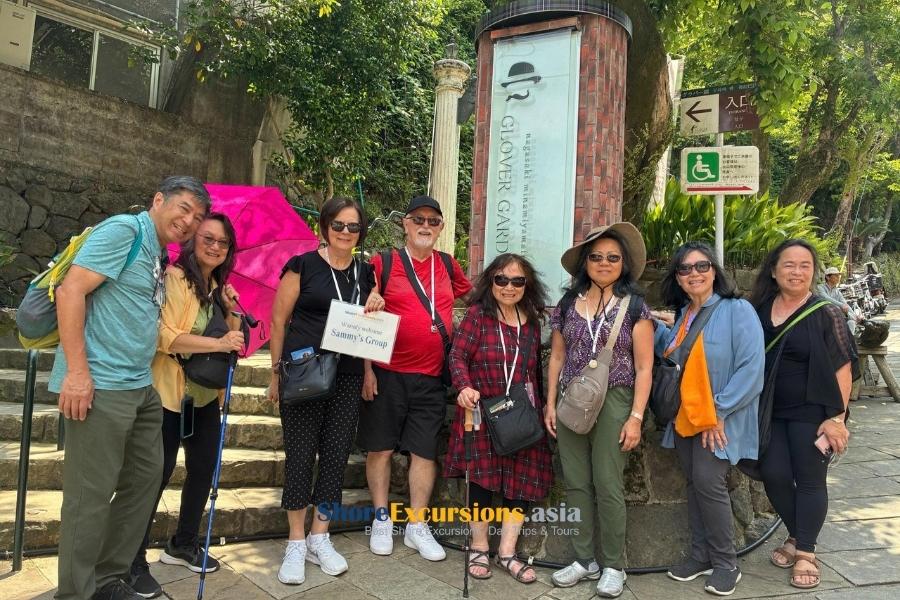
Planning is key for a smooth accessible travel experience in Japan. Here’s what to keep in mind before departure:
- Medical preparation: Bring doctor’s notes, translated prescriptions, and essential medications.
- Wheelchair size & type: Many train doors and elevators have width restrictions. If you use a power wheelchair, check weight and battery requirements for flights and Shinkansen.
- Travel insurance: Make sure it covers mobility aids, medical emergencies, and equipment rental.
- Route planning: Japan’s rail network is vast. Choose routes with fewer transfers and allow extra time for station assistance.
Apps to download:
- Google Maps (with offline maps)
- Japan Toilet Map / Check-a-Toilet for multipurpose restrooms
- VoiceTra for instant Japanese–English translation
Tip: Write down a short note in Japanese explaining your mobility needs (“I use a wheelchair, I need an elevator/ramp, can you help?”). Showing this to station staff can make communication easier.
Air Travel & Airports in Japan
For many visitors, the journey begins the moment they land, and Japan’s airports are some of the most barrier-free travel hubs in the world. In many airports such as Tokyo Haneda (HND), Narita International (NRT), Kansai International (KIX) near Osaka, or Chubu Centrair (NGO) in Nagoya, you’ll find thoughtful design and services that make the experience smooth for wheelchair users and travelers with special needs.
- Request assistance in advance: Notify your airline and the airport when booking. Staff can escort you through security, immigration, and to your gate.
- Wheelchair rental: Haneda and Narita offer wheelchair rental both inside and outside terminals.
- Facilities: Multipurpose toilets, wide elevators, tactile paving, and priority lanes for passengers with disabilities.
- Smaller regional airports: Many are improving, but some have limited lifts or ramps for boarding. Therefore, always check before booking domestic flights.
How to Get Around with Assessible Travel Japan
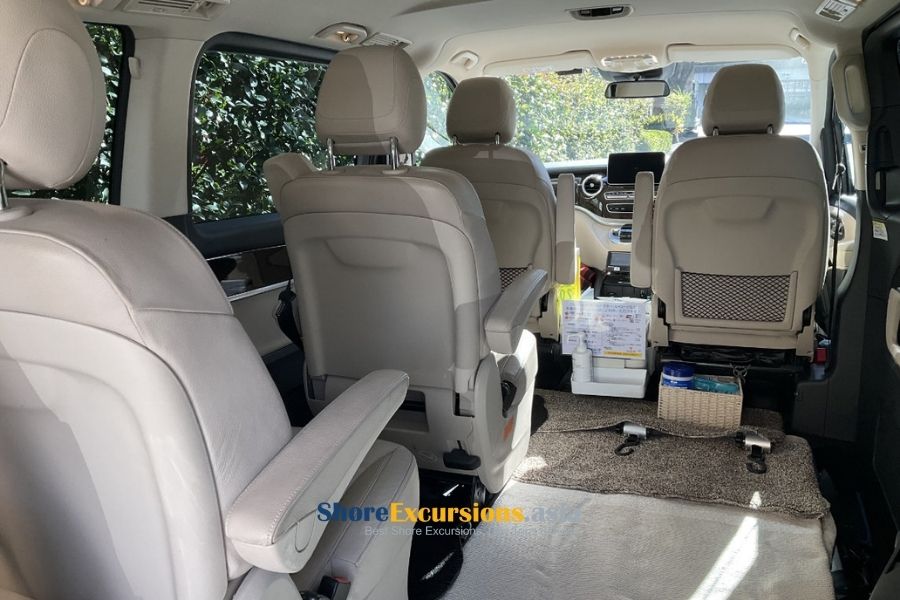
Transportation is at the heart of every journey, and in Japan, moving from city to city or exploring local neighborhoods can be a joy, even for travelers with mobility needs. Thanks to its world-class infrastructure, accessible travel in Japan has never been easier.
1. JR System and Shinkansen
Japan’s JR (Japan Railways) network and Shinkansen high-speed trains are among the best examples of accessibility in action. Many Shinkansen cars include designated wheelchair spaces and multipurpose restrooms equipped with wide doors, grab bars, and flat entryways. Passengers who need these features should reserve a wheelchair seat or multipurpose compartment in advance.
At major stations, JR staff provide excellent assistance. They help passengers board with portable ramps and coordinate with staff at the destination station to assist upon arrival. This level of support has made the Shinkansen one of the most comfortable and reliable options for accessible travel in Japan.
2. Subways and Smaller Stations
Most subway systems in major cities like Tokyo, Osaka, and Yokohama have been modernized to include elevators, tactile paving, and barrier-free restrooms. These improvements make it easier for travelers using wheelchairs or mobility aids to move between attractions and transport hubs. Station staff are also trained to offer help when needed, ensuring a safe and organized travel experience.
However, older or rural stations can still present challenges, as some may lack elevators or step-free access. Before heading out, it’s a good idea to check the accessibility information on railway websites or mobile apps. For travelers focusing on accessible travel in Japan, taking time to confirm accessibility details in advance prevents inconvenience and helps maintain a relaxed schedule throughout the trip.
3. Buses and Accessible Taxis
City buses in Tokyo, Osaka, and other large cities are increasingly equipped with low floors and ramps, making boarding easier for wheelchair users. Designated spaces inside the bus allow travelers to ride safely and comfortably. Although local buses in smaller towns may not yet have these features, the network continues to improve year by year.
For greater flexibility, wheelchair-accessible taxis are available in most large cities. These vehicles are designed with ramps or lifts, making transfers simple and secure. Because the number of accessible taxis is limited, advance reservations are strongly recommended. Using an accessible taxi can be a practical solution when visiting temples, shrines, or other sites that are not directly connected to public transportation.
Accessible Accommodation for Senior Travelers in Japan
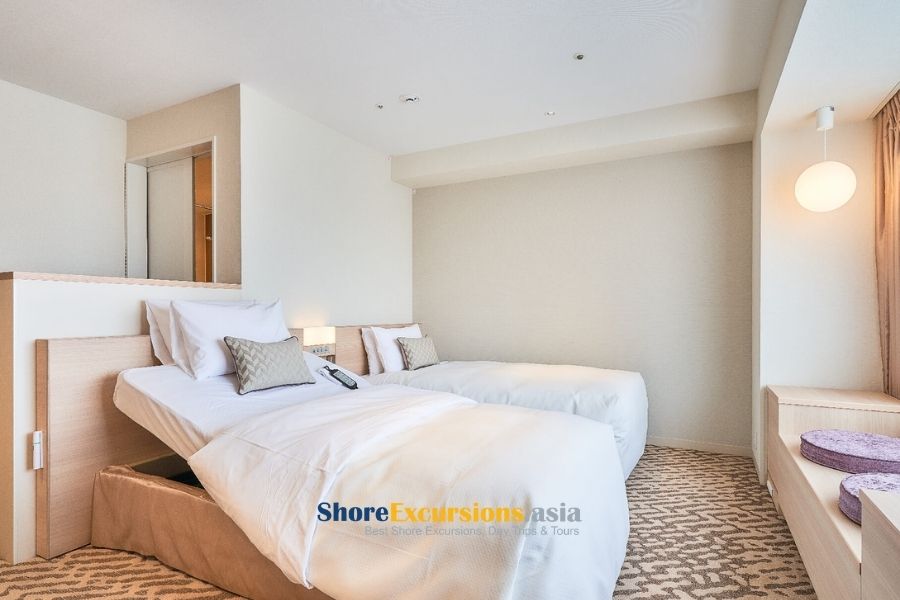
Choosing the right place to stay can make a huge difference in how comfortable and enjoyable your journey feels. For anyone planning accessible travel in Japan, the country offers a growing number of hotels, ryokan, and guesthouses designed with mobility and accessibility in mind. These properties are easy to find in major cities, and their attention to detail reflects Japan’s strong commitment to barrier-free tourism.
1. Hotels with Barrier-Free Rooms
Large international hotels and modern Japanese chains in cities such as Tokyo, Osaka, and Kyoto often feature barrier-free rooms specifically designed for guests with limited mobility. These rooms typically include roll-in showers, non-slip bathroom floors, grab bars beside the toilet and bathtub, and wider doorways that allow wheelchairs to pass comfortably. Many also provide adjustable beds and emergency call buttons for additional safety.
Guests planning accessible travel in Japan can expect a high level of hospitality. Hotel staff are generally well-trained to assist with luggage, room adjustments, and arranging accessible transportation. Newer properties even highlight accessibility features in their listings, making it easier to choose accommodations that meet individual needs.
2. Traditional Ryokan Inns for Limited Mobility Guests
For travelers who want to experience traditional Japanese culture, staying in a ryokan can be memorable. Some ryokan have undergone renovations to include accessible rooms with wider entrances and modified bathrooms. A few even provide Western-style beds instead of futons, making them more suitable for travelers using wheelchairs or those who find it difficult to sit on tatami floors.
However, not all ryokan are fully barrier-free. Many still have steps at the entrance or inside guest areas, and traditional baths may not be easily accessible. Before confirming a reservation, it is important to contact the property directly to ask about room layout, doorway width, and available assistance. Taking time to check these details ensures that your stay aligns with the comfort level you expect during your accessible travel in Japan.

3. How to Confirm Accessibility of Accommodations
Online travel platforms such as Booking.com and Agoda allow users to filter search results for “accessible rooms.” This feature is helpful for narrowing down options, but it should not replace direct communication with the hotel. While many hotels now advertise barrier-free rooms online, it’s always best to verify accessibility details directly with the property before booking. A quick email or phone call can help you avoid unexpected obstacles and ensure a comfortable stay.
Here are the key points to confirm with your hotel:
- Step-free access: Ask if there are any stairs at the entrance, in the lobby, or on the way to your room. Confirm that elevators are available and large enough for your wheelchair or mobility aid.
- Room dimensions: Check doorway width, hallway space, and bed height to ensure easy movement inside the room.
- Bathroom design: Confirm that the shower is roll-in or has a flat entry, and that grab bars are installed near the toilet and bathtub.
- Accessible restrooms in public areas: Ask if the hotel has barrier-free toilets available in common spaces such as the lobby or restaurant.
- Parking and entrances: If you are using an accessible taxi or private vehicle, check whether the hotel provides designated accessible parking spaces or a covered drop-off area.
- Communication and support: Request photos of the room or bathroom layout if available. Many hotels are happy to share images and provide additional details in English.
Assessible Sightseeing and Attractions in Japan
Exploring Japan’s landmarks, cultural sites, and urban attractions is one of the most rewarding parts of any trip. Many destinations have invested heavily in universal design, making sightseeing an enjoyable and stress-free experience for travelers focusing on accessible travel in Japan.
1. Museums & Modern Attractions
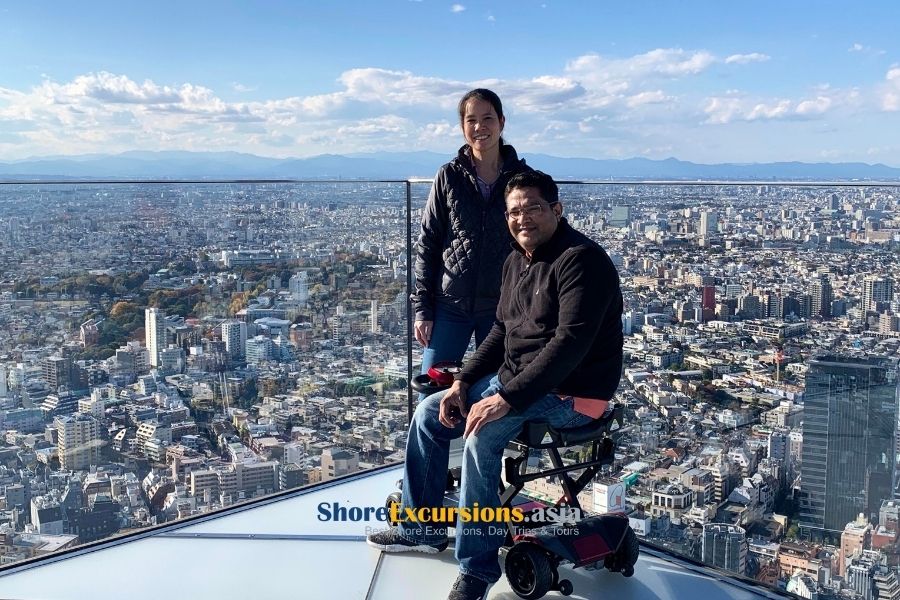
Japan’s modern attractions reflect the country’s dedication to inclusive tourism. Many museums, aquariums, and cultural centers have been designed with barrier-free facilities that make exploration easy for everyone. These spaces show how much attention Japan gives to comfort, safety, and accessibility.
Key highlights for accessible visitors who desire for museum and more include:
- Tokyo Skytree: Equipped with wide elevators, spacious observation decks, and accessible restrooms. Staff provide assistance upon request.
- Osaka Aquarium Kaiyukan: Features smooth pathways, ramps, and large viewing areas ideal for wheelchair users.
- National Art Center Tokyo: Offers barrier-free exhibition halls, tactile guidance systems, and multilingual information counters.
- TeamLab Planets Tokyo: Provides dedicated routes for wheelchairs and assistance for visitors who need additional support.
- Shopping complexes such as Ginza Six and Roppongi Hills: Include elevators, wide corridors, and well-marked accessible restrooms.
Most large attractions also offer tactile exhibits or audio guides in multiple languages, making cultural discovery enjoyable for travelers with visual or hearing impairments. These facilities represent the modern side of accessible travel in Japan, where comfort and design go hand in hand.
2. Japanese Temples & Shrines
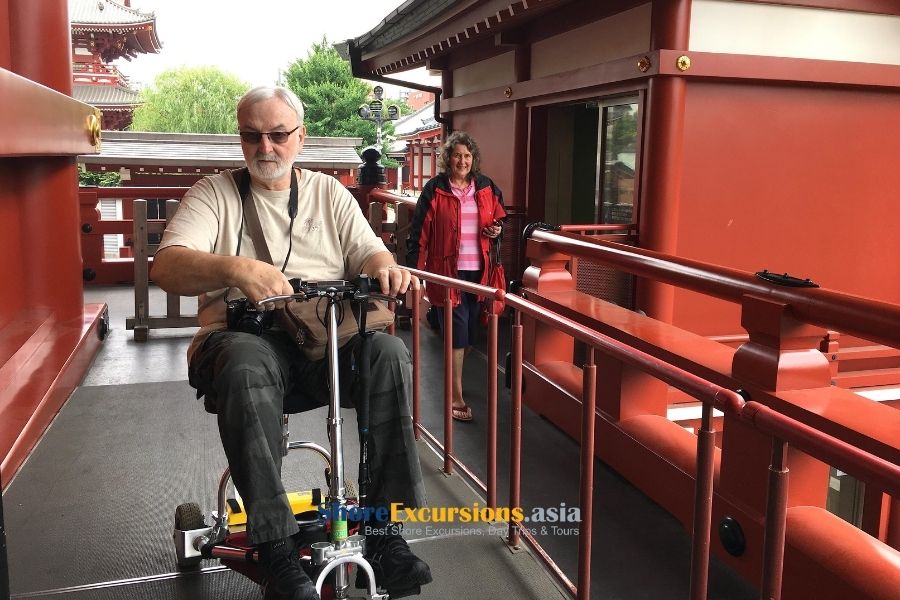
Historic temples and shrines are the soul of Japan’s cultural heritage. In the past, accessibility was limited because of steep stairs and uneven paths, but continuous improvements now make many sacred sites easier to visit. This progress allows travelers with mobility needs to take part in authentic cultural experiences.
Popular religious and heritage sites with improved accessibility include:
- Kiyomizu-dera (Kyoto): Recently installed ramps and gentle slopes allow visitors to reach main viewing areas overlooking Kyoto.
- Senso-ji Temple (Tokyo): Offers paved walkways and accessible facilities throughout its temple grounds.
- Osaka Castle: Features modern elevators connecting each floor to the observation deck with panoramic city views.
- Meiji Jingu Shrine (Tokyo): Provides wide, flat pathways through forested grounds, suitable for wheelchairs and mobility scooters.
- Todaiji Temple (Nara): Includes accessible entrances and smooth surfaces near the Great Buddha Hall.
These enhancements show Japan’s dedication to preserving tradition while embracing inclusion. For many travelers, exploring these sites marks one of the most meaningful moments in accessible travel in Japan, combining deep cultural beauty with thoughtful design.
Accessible Shore Excursions for Cruise Passengers
Cruising is one of the most relaxing ways to explore Japan, and many of the country’s ports are now equipped to support travelers with mobility needs. The growth of accessible travel in Japan has encouraged port authorities and tour operators to create smoother, barrier-free experiences for visitors who want to enjoy Japan’s culture and scenery during their short time ashore.
Key Ports for Accessible Cruisers
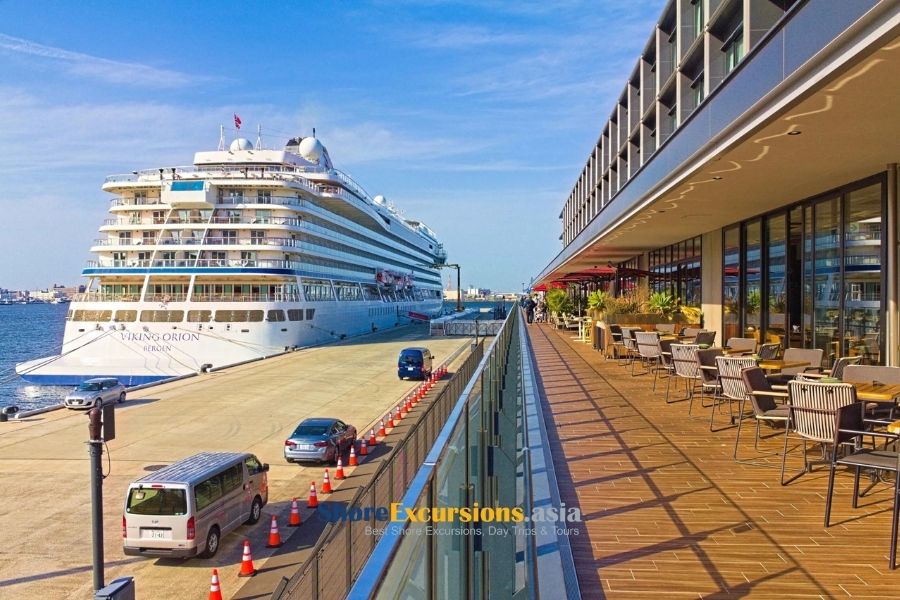
Japan’s major cruise ports have invested heavily in accessibility upgrades, making disembarkation and sightseeing more comfortable for travelers using wheelchairs or mobility aids.
- Yokohama (Gateway to Tokyo): The Osanbashi Cruise Terminal features wide ramps, accessible elevators, and spacious restrooms. It connects directly to the city’s train system and nearby attractions like Minato Mirai and the Cup Noodles Museum.
- Kobe: This modern terminal serves as an ideal entry point for exploring Osaka and Kyoto. Passengers will find barrier-free facilities, tactile paving for the visually impaired, and staff trained to assist guests with mobility needs.
- Nagasaki, Fukuoka (Hakata), and Okinawa (Naha): These newer terminals generally meet international accessibility standards. Some shuttle buses to city centers may not be fully wheelchair accessible, so arranging private transport in advance is recommended.
These upgrades make cruising a practical and enjoyable option for anyone interested in accessible travel in Japan, allowing travelers to experience the country’s ports without unnecessary stress.
Booking Accessible Shore Excursions in Japan
Planning ahead is key to a smooth onshore experience. Cruise lines often provide accessible tours, but the number of available spaces is limited. Reserving early ensures you secure the best options for your mobility needs.
- Cruise line excursions: Check the cruise operator’s website or onboard tour desk for accessible tour listings. Some itineraries specifically mention wheelchair-friendly buses and routes.
- Private tours: Local specialists such as Accessible Japan and Japan Accessible Tourism Center offer customized excursions with lift-equipped vans and experienced guides who understand mobility requirements.
- Information to request: Before booking, confirm the type of vehicle, ramp or lift availability, and the number of wheelchair spots. Clear communication helps avoid surprises once you arrive at the port.
These preparations are an important part of accessible travel in Japan, helping you make the most of your limited time ashore.
Suggested Accessible Excursions in Japan
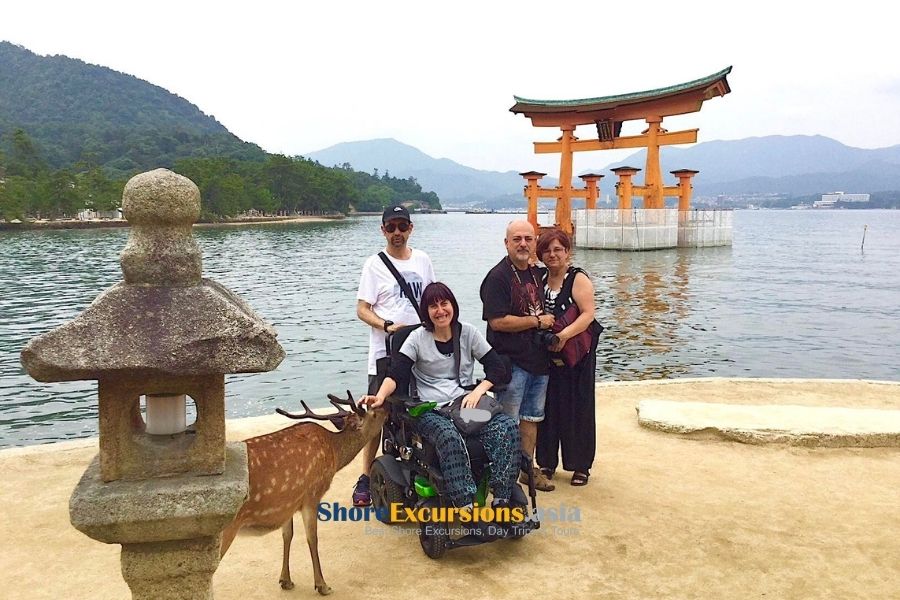
Japan’s coastal cities combine convenience with culture, offering many memorable sights that accommodate travelers of all abilities. Each of these excursions reflects Japan’s growing commitment to accessible travel, ensuring that cultural exploration is available to all visitors.
- Tokyo / Yokohama: Explore the waterfront district of Minato Mirai, visit the interactive Cup Noodles Museum, or stroll through the partially accessible Sankeien Garden.
- Osaka / Kyoto (via Kobe Port): Visit Osaka Castle, Nijo Castle, or select temples in Kyoto that have ramps and accessible pathways.
- Nagasaki: Learn about history at the Peace Park and the Atomic Bomb Museum, both offering elevator access and wide interior spaces.
- Okinawa: Discover the Churaumi Aquarium, one of the world’s largest, or visit parts of the reconstructed Shurijo Castle with accessible routes and scenic viewpoints.
Cruise Traveler Accessibility Checklist
To make the most of your time in port, a little preparation goes a long way. Keep these essentials in mind before your trip:
- Notify your cruise line of your accessibility requirements during the booking process.
- Confirm whether “accessible” tours are fully wheelchair-friendly or designed for limited walking.
- Pre-book accessible taxis or vans at each port of call.
- Bring necessary medications and travel essentials since shore time is often limited.
- Keep the local port agent’s contact information handy; it’s usually printed on your cruise card.
Proper planning transforms a brief port visit into a memorable experience. As Japan continues to enhance its infrastructure and hospitality, cruising has become an increasingly enjoyable way to experience accessible travel in Japan.
In conclusion, accessible travel in Japan is not only possible, it can be a truly rewarding experience. With careful planning, support from Japan’s barrier-free infrastructure, and the right tools, wheelchair users and travelers with mobility needs can explore this incredible country with confidence.





